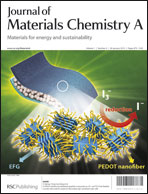A novel method to self-assemble PMo12 on CNTs followed by a thermal treatment under hydrogen was developed for a highly dispersed Mo2C/CNTs hybrid and was further used to support Pd towards formic acid oxidation. TEM examinations show that the CNTs are uniformly covered by Mo2C particles with a diameter of 1–2 nm. The Pd–Mo2C/CNTs catalyst exhibits a more negative onset potential (−0.16 V) than Pd/CNTs (−0.13 V) and Pd/C (−0.12 V), showing the highest intrinsic electrocatalytic activity, while its peak current density (845 mA mg−1 Pd) is ∼1.6 and 2.3 times higher than that of Pd/CNTs (534 mA mg−1 Pd) and Pd/C (371 mA mg−1 Pd), indicating the highest electroactive surface area. The Pd–Mo2C/CNTs catalyst also demonstrates excellent long-term stability, which is likely to have contributions from the incorporation of Mo2C that significantly enhances the dehydrogenation path while lessening the dehydration path, resulting in the poisoning reduction of the Pd catalysts. It is reasonably proposed that the assembled Mo2C acts not only as a support to enhance the catalyst uniformity, but also as a co-catalyst to directly promote both electrocatalytic activity and stability. This work provides an efficient method to prepare Mo2C/CNTs as a promising support towards oxidation of small organic molecules in fuel cells.

You have access to this article
 Please wait while we load your content...
Something went wrong. Try again?
Please wait while we load your content...
Something went wrong. Try again?


 Please wait while we load your content...
Please wait while we load your content...